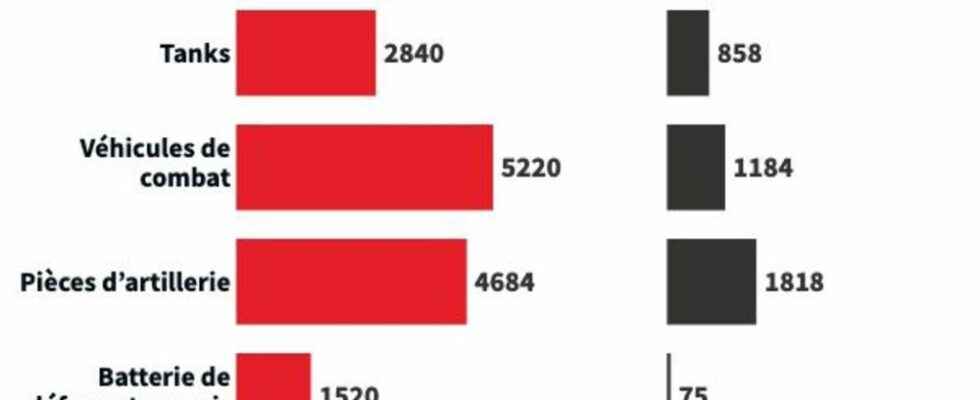The dreaded scenario has begun. At 5:30 a.m. this Thursday, February 24, Vladimir Putin announced on Russian television the launch of a “special military operation” intended to “demilitarize and denazify” Ukraine. Half an hour later, the first bombardments affected the whole of Ukrainian territory, followed by a rapid entry of Russian ground forces. “Don’t panic, we are ready for anything, replied Ukrainian President Volodymyr Zelensky in a resolute tone but without triumphalism. We will win.”
In 2014, the Ukrainian army suffered a rout in Crimea and the east of the country against Russian and pro-Russian separatist forces. Can they hope to resist the steamroller this time? “The Ukrainian army of 2022 is no longer that of 2014, warns General Dominique Trinquand, military expert and former head of the French mission to the UN. It is now much larger and better trained, in particular thanks to the support of Western forces.” Where in 2014 the Ukrainian army counted 130,000 poorly trained and poorly equipped soldiers in its ranks – half of them conscripts – it now has 209,000 members of the regular armed forces as well as 900,000 reservists, according to figures from the International Institute for Strategic Studies (IISS).
At the same time, military spending has almost doubled, from 3 billion dollars (2.6 billion euros) in 2014 to almost 6 billion in 2020, according to the world Bank. Added to this is NATO aid estimated at $14 billion since 2014, to help Kiev modernize its artillery. In November 2021, Washington had notably delivered to Ukraine around 88 tons of ammunition, three dozen Javelin launchers and 180 missiles.
A technologically outclassed army
Still, in the comparison game, Ukraine is still a strategic dwarf next to Russia, whose military spending is ten times higher ($61 billion in 2020). Similarly, beyond the 190,000 soldiers that Russia had massed around Ukraine in recent months, Moscow can field a total of 900,000 soldiers and 2 million reservists. However, the Russian advantage is not only quantitative. “The Russian army is technologically much more modern, has a more advanced strike force capability and asymmetric levers that are without comparison with Ukraine”, slice Mathieu Boulègue, researcher specializing in Eurasia at Chatham House, a London think tank.
L’Express/Dario Ingiusto
The Ukrainian air force – with few men and worm-eaten – appears to be one of Kiev’s great weaknesses. “Some aircraft date from the Soviet era and their pilots have only a few flying hours. Russia, on the other hand, has much more modern and more numerous planes”, draws up Glen Grant, analyst at Baltic Security Foundation advising Ukraine on its military reform. Not to mention that Moscow can rely on better trained pilots, most of whom have carried out missions in Syria since the start of the Russian intervention in 2015.
L’Express/Dario Ingiusto
The same goes for the Ukrainian Navy, which has only 11,000 members, compared to 150,000 on the Russian side. For lack of having made the costly necessary investments, it is all of the Ukrainian heavy equipment that displays too many hours on the meter. “The modernization program was underway, but it is far from over, observes Glen Grant. Many vehicles are in poor condition and are technologically outclassed by Russia.”
“Not a health walk”
However, the colossal difference in resources between the two armies is not the only factor in the equation. “Unlike Russian soldiers who engage above all to earn a living, Ukrainian soldiers do so to defend their country and are ready to fight until the end, underlines Glen Grant. This constitutes a fundamental difference in regarding the morale of the troops.” Over the eight years of war in the Donbass, they have also acquired combat experience that they did not have in 2014.
“The complete invasion of Ukraine will not be a walk in the park, abounds General Trinquand. The large number of combat zones will necessarily result in losses on the Russian side.” This Thursday, February 24, Ukrainian President Volodymyr Zelensky gave the order “that maximum losses be inflicted on the aggressor”, indicated the Commander-in-Chief of the Ukrainian Armed Forces, General Valery Zalujni, assuring that his army “counters with dignity” enemy attacks.
Beyond the members of its regular armed forces, Kiev has also taken care to train reservists and civilians in guerrilla techniques in recent weeks, in particular with its “territorial defense battalions” set up by the law on national resistance adopted at the beginning of January. According to a survey carried out in December by the Kiev International Institute of Sociology (KIIS), one in three Ukrainians say they are ready to take up arms in the face of a Russian invasion, while 21.7% of the others are ready to join a civil resistance movement .
“In the short term, Russia’s military victory is hardly in doubt. On the other hand, in the long term, Russian stalemate is probable”, summarizes General Trinquand. Questioned this Thursday, the spokesman of the Kremlin Dmitri Peskov declared that the military operation would last “the necessary time”…
